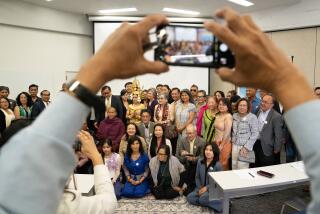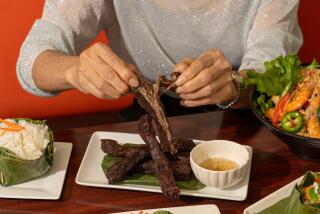National Agenda : Factor X: The Khmer Rouge in Cambodia’s Elections : The Communist faction is boycotting the vote. But it’s still the most terrifying force in the country.
PHNOM PENH, Cambodia — There are 20 political parties of all descriptions battling it out in this week’s general elections in Cambodia. But in many respects, the most significant--and certainly the most terrifying--force in the country is the party watching angrily from the sidelines.
The missing group is the Khmer Rouge, or Red Khmer, the name given by Prince Norodom Sihanouk in the 1960s to Cambodia’s clandestine Communist group. Officially they are the “Party of Democratic Kampuchea,” but most Cambodians know them simply as the dreaded angkar : The Organization.
The Khmer Rouge originally signed the October, 1991, peace agreement, which gave the United Nations the authority to conduct “free and fair” elections for a new parliament. But for reasons that are still something of a mystery, the group changed its mind last year and has vociferously denounced the ballot as an imperialist plot.
It would be easy to write off the Khmer Rouge’s often paranoid ravings about the elections as the delusions of 1960s radicals who have spent too many years in the jungle. But the organization still commands a disciplined, battle-hardened army with which the next government of Cambodia--no matter who wins this week’s vote--will have to contend. So the $64,000 question in Cambodia today is: What exactly does the Khmer Rouge want?
Judging by its own propaganda and interviews with analysts who have tracked the group in recent years, the Khmer Rouge wants a piece of the political pie even though it is not taking part in the election. By using force and intimidation, it hopes to discredit the elections in the eyes of the world.
As Cambodian leaders try to pick up the pieces, the Khmer Rouge wants to be included in a government of “national reconciliation,” according to this theory. And even if that doesn’t work, it hopes to loom so large and menacing that it at least won’t be ignored.
Citing Mao Tse-tung’s adage that political power springs from the barrel of a gun, many Cambodians are afraid that the Khmer Rouge is simply too powerful to be excluded from power. Without a deal, the political realists argue, a return to civil war is inevitable. And for many who endured its cruelty, any role for the Khmer Rouge is too much.
Publicly, the Khmer Rouge insists its goals are modest.
“We don’t ask for important portfolios (in the Cabinet)--even a folding chair would be acceptable. I want to make clear that the DK (Khmer Rouge) does not want to come back to power,” Khieu Samphan, the nominal leader of the group, has told an inteviewer.
Much of the political debate in the election campaign over the past six weeks has been shaped by ideas on how to deal with the Khmer Rouge problem.
For the Phnom Penh government headed by Prime Minister Hun Sen, the answer is simple: A fight to the finish. But rivals such as the royalist faction headed by Sihanouk’s son, Prince Norodom Ranariddh, have won popularity in this war-weary country by promising to negotiate with the Khmer Rouge. Their line is basically: Let’s give peace a chance. The election could turn on the question of whether voters believe they can still trust the Khmer Rouge.
Headed by a Maoist revolutionary named Pol Pot, the “Red Khmer” ruled Cambodia from 1975 to early 1979, holding up a vision of achieving the perfect socialist state by returning the country to the year zero. The regime emptied the cities and sent professionals into the paddy fields, presiding over one of the great holocausts of modern times. Estimates vary, but most experts agree that more than 1 million Cambodians, in a nation of only 8 million, died through starvation, disease and political purges.
Cambodians have made a monument out of Tuol Sleng, a former high school that became the Khmer Rouge interrogation center in Phnom Penh. A mountain of skulls was found there in 1979 after Vietnamese troops invaded Cambodia and toppled the Pol Pot regime. A group of Khmer Rouge who had defected to Vietnam was installed as the new government in Phnom Penh.
Although nearly crushed by the more powerful Vietnamese army, the Khmer Rouge proved resilient, thanks in part to an unusual alliance between China, Thailand and the United States.
China wanted to punish Vietnam for invading Cambodia, Thailand worried about Vietnam’s expansionist aims and the United States, still smarting from its military defeat in Vietnam, was flirting with China to offset Soviet influence. So the Khmer Rouge was allowed to operate as a guerrilla group out of Thailand and allowed to hold Cambodia’s U.N. seat.
While the United States has long since repudiated its affiliations with the Khmer Rouge, China and Thailand have never broken their links. Logs and gems from areas under Khmer Rouge control pass through Thai border checkpoints on their way to market, and supplies such as fuel come in the same way.
Western diplomats noted that despite promises from the government of Thai Prime Minister Chuan Leekpai to respect U.N. Security Council resolutions to close the border to such trade, a sprawling new Khmer Rouge base, complete with warehouses and bunkers, opened recently just half a mile from the Thai border. The assumption is that such a huge installation, connected to Thailand by new roads, could not operate without the sanction of the Thai authorities.
Analysts believe that the Khmer Rouge fields an army of perhaps 12,000 fighters, with another 8,000 to 10,000 people in support. The central government’s army is far larger, but lack of pay and high-level corruption have sapped its morale.
Most diplomats believe that China, freed of its fears of being surrounded by Soviet puppets, pressured the Khmer Rouge into signing the four-party peace agreement in 1991. The peace plan called for a 15-month prelude to the elections, during which U.N. troops would arrive and supervise the disarming of the four factions.
But the peace plan began going awry almost from the start. Khieu Samphan, the French-educated economist who is now the nominal leader of the Khmer Rouge while Pol Pot continues to lead the group from the jungle, was beaten up by a government-organized mob when he first returned to Phnom Penh under the peace plan.
The Khmer Rouge felt virtually from the start that the United Nations, which was pledged to treating the four factions equally, was in fact following a hidden Western agenda to undermine it. The group kept demanding--without success--that the Phnom Penh administration be dismantled or at least controlled by the United Nations.
The final straw for the group came in April, 1992, when the United Nations announced a program of $800-million “budgetary support” for the Cambodia operation, most of which benefited the Phnom Penh government. The Khmer Rouge saw this as direct U.N. support for its sworn enemies.
Many Western diplomats regard the Khmer Rouge complaints of bias, although somewhat justified, as a smoke screen to conceal its larger concerns: that it never intended to place its army under the control of the United Nations, disarm and open its areas of control to U.N. inspection. It would have gotten clobbered at the polls and would have no club to wield afterward.
In June, 1992, when the deadline came to place its troops in military encampments, the Khmer Rouge refused to go along, accusing the United Nations of failing to rid Cambodia of Vietnamese troops.
Since then, the group has poured scorn on the U.N. plan to hold a “dirty election aimed at killing the Cambodian nation and people, maintaining old and new Vietnamese forces and legalizing the Vietnamese puppets.” Khmer Rouge representatives withdrew from Cambodian cities and retreated to their jungle hide-outs. The group also began a series of attacks on ethnic Vietnamese civilians that resulted in the deaths of 60 people and caused an exodus of thousands of others.
Before the Khmer Rouge finally left the Cambodian capital last month, Khieu Samphan told the Phnom Penh Post newspaper that the “Cambodian people are in a very angry mood.”
“We can foresee that the situation will get more unstable, more insecure, more confusing,” he warned.
Over the past few weeks, the group has warned voters to stay away from the polls or face reprisals in their villages--a potent threat given the Khmer Rouge history. In a weekend report, a U.N. human rights official blamed the group for 131 of 200 deaths in pre-election attacks. The Khmer Rouge tactics constitute a finely calculated gamble, however, because they may so thoroughly scare the electorate that voters will flock to the embrace of the Phnom Penh government.
Halfway through the six-day election, U.N. officials reported an unexpectedly heavy and enthusiastic turnout at the polls despite fears of violence.
At a press conference last week, Hun Sen made clear that if he wins, the Phnom Penh authorities plan to fight the Khmer Rouge--not in a civil war, but as the legitimate government in Cambodia combatting an outlaw insurgency. The marginalizing of the Khmer Rouge is a real possibility.
But if there is no clear winner in the election, the parties may turn to Sihanouk, the acknowledged father figure of Cambodian politics, to form a government of national reconciliation, which he has said he will do. Such an arrangement would be anathema to the Khmer Rouge defectors in Phnom Penh, but they could have little choice because of Sihanouk’s popularity.
In a radio broadcast, the Khmer Rouge declared that the group wants “to set up a four-party provisional government of national reconciliation” with Sihanouk as president and prime minister and representatives of all groups in the government.
Asked what he thought was the Khmer Rouge strategy, one Western diplomat who has followed the group for two decades quoted a famous Cambodian proverb: “Ride a water buffalo across the mud,” he said. “In other words, do something for temporary advantage. Stall, delay, preserve your forces until you sense an opportunity to return to power.”
A Short, Brutal History of the Khmer Rouge
* Maoist revolutionary Pol Pot and his “Red Khmer” ran Cambodia from 1975 to 1979, emptying the cities and killing presumed opponents.
Under their savage rule, more than 1 million Cambodians are believed to have died in a modern holocaust of starvation, disease and political purges.
The Vietnamese invaded Cambodia and toppled Pol Pot and his regime in 1979. But the Khmer guerrillas, numbering maybe 12,000, have been resilient.
In 1991, they signed a peace pact that called for free elections. But they later repudiated it and are still fighting the Phnom Penh government and the United Nations.
Pol Pot, in hiding, remains the leader. But the nominal executive is French-educated economist Khieu Samphan.
More to Read
Sign up for Essential California
The most important California stories and recommendations in your inbox every morning.
You may occasionally receive promotional content from the Los Angeles Times.










